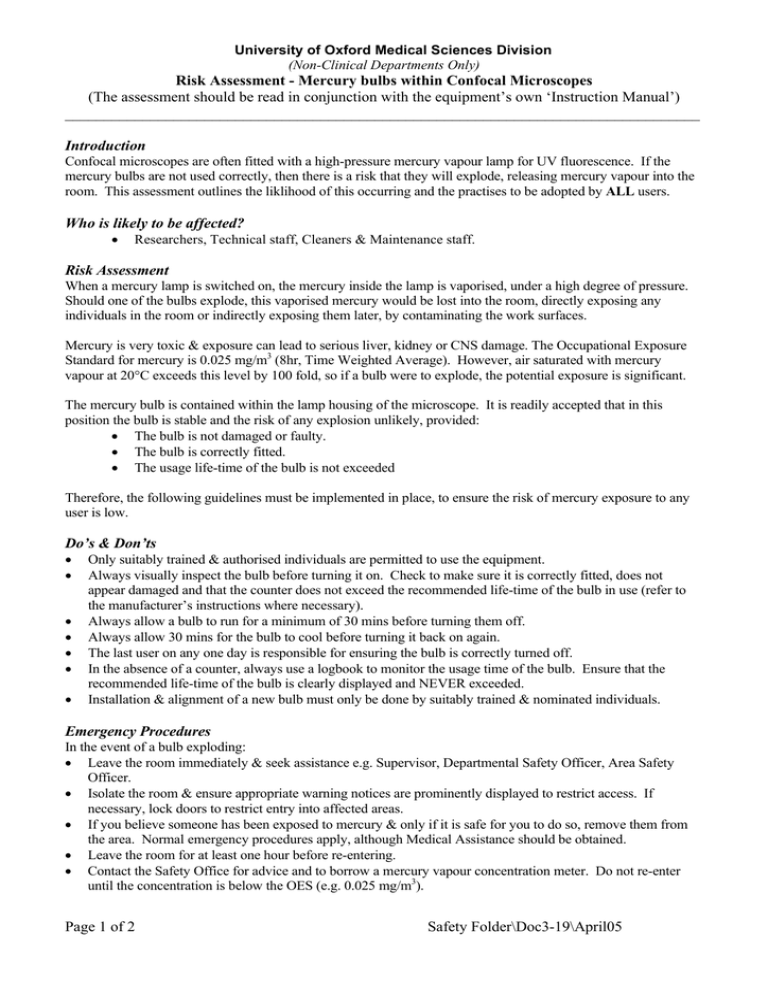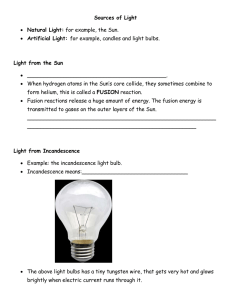Mercury Bulbs within Microsocpes
advertisement

University of Oxford Medical Sciences Division (Non-Clinical Departments Only) Risk Assessment - Mercury bulbs within Confocal Microscopes (The assessment should be read in conjunction with the equipment’s own ‘Instruction Manual’) __________________________________________________________________________________ Introduction Confocal microscopes are often fitted with a high-pressure mercury vapour lamp for UV fluorescence. If the mercury bulbs are not used correctly, then there is a risk that they will explode, releasing mercury vapour into the room. This assessment outlines the liklihood of this occurring and the practises to be adopted by ALL users. Who is likely to be affected? • Researchers, Technical staff, Cleaners & Maintenance staff. Risk Assessment When a mercury lamp is switched on, the mercury inside the lamp is vaporised, under a high degree of pressure. Should one of the bulbs explode, this vaporised mercury would be lost into the room, directly exposing any individuals in the room or indirectly exposing them later, by contaminating the work surfaces. Mercury is very toxic & exposure can lead to serious liver, kidney or CNS damage. The Occupational Exposure Standard for mercury is 0.025 mg/m3 (8hr, Time Weighted Average). However, air saturated with mercury vapour at 20°C exceeds this level by 100 fold, so if a bulb were to explode, the potential exposure is significant. The mercury bulb is contained within the lamp housing of the microscope. It is readily accepted that in this position the bulb is stable and the risk of any explosion unlikely, provided: • The bulb is not damaged or faulty. • The bulb is correctly fitted. • The usage life-time of the bulb is not exceeded Therefore, the following guidelines must be implemented in place, to ensure the risk of mercury exposure to any user is low. Do’s & Don’ts • • • • • • • Only suitably trained & authorised individuals are permitted to use the equipment. Always visually inspect the bulb before turning it on. Check to make sure it is correctly fitted, does not appear damaged and that the counter does not exceed the recommended life-time of the bulb in use (refer to the manufacturer’s instructions where necessary). Always allow a bulb to run for a minimum of 30 mins before turning them off. Always allow 30 mins for the bulb to cool before turning it back on again. The last user on any one day is responsible for ensuring the bulb is correctly turned off. In the absence of a counter, always use a logbook to monitor the usage time of the bulb. Ensure that the recommended life-time of the bulb is clearly displayed and NEVER exceeded. Installation & alignment of a new bulb must only be done by suitably trained & nominated individuals. Emergency Procedures In the event of a bulb exploding: • Leave the room immediately & seek assistance e.g. Supervisor, Departmental Safety Officer, Area Safety Officer. • Isolate the room & ensure appropriate warning notices are prominently displayed to restrict access. If necessary, lock doors to restrict entry into affected areas. • If you believe someone has been exposed to mercury & only if it is safe for you to do so, remove them from the area. Normal emergency procedures apply, although Medical Assistance should be obtained. • Leave the room for at least one hour before re-entering. • Contact the Safety Office for advice and to borrow a mercury vapour concentration meter. Do not re-enter until the concentration is below the OES (e.g. 0.025 mg/m3). Page 1 of 2 Safety Folder\Doc3-19\April05 University of Oxford Medical Sciences Division (Non-Clinical Departments Only) Risk Assessment - Mercury bulbs within Confocal Microscopes (The assessment should be read in conjunction with the equipment’s own ‘Instruction Manual’) __________________________________________________________________________________ • • • When it is safe to re-enter the room, remove the lamp housing to a fume cupboard and leave it open to fully dissipate for a further 24 hours. Collect all potentially contaminated glass and bulk fragments for disposal via the hazardous chemical waste stream. Record the incident in the Accident Book. Critical Symptoms to be aware of for Mercury Exposure are: Skin – There may be only mild irritation at the site of contact, but severe burns with blister formation could occur. Mercury can be readily absorbed by the skin & could therefore cause symptoms similar to inhalation or ingestion. Eye – There may be only mild irritation, but corneal burns could occur. Inhalation – Mild poisoning causes vomiting, diarrhoea and a metallic taste in the mouth. Severe poisoning causes abdominal pain, shock, bloody diarrhoea and damage to the kidneys. Ingestion – There may be a headache with a metallic taste in the mouth, dizziness, slurred speech and a staggering walk. Increased salivation and painful red gums could occur. Severe poisoning could cause convulsions and kidney damage. Page 2 of 2 Safety Folder\Doc3-19\April05


